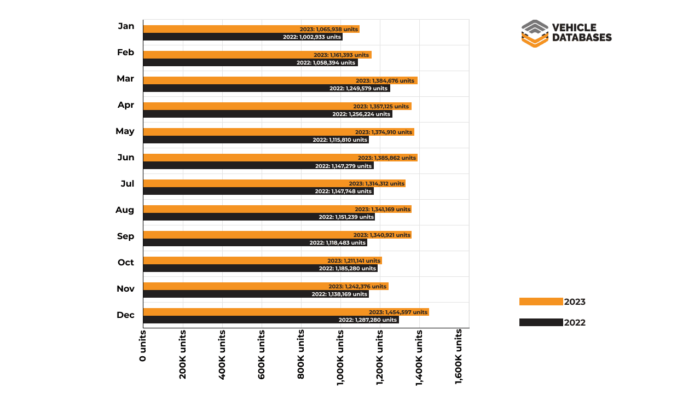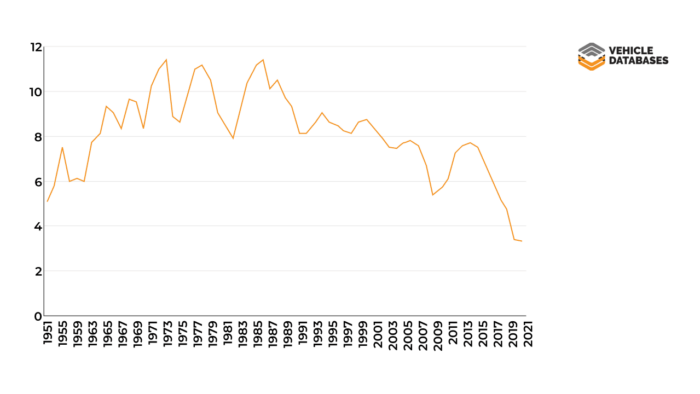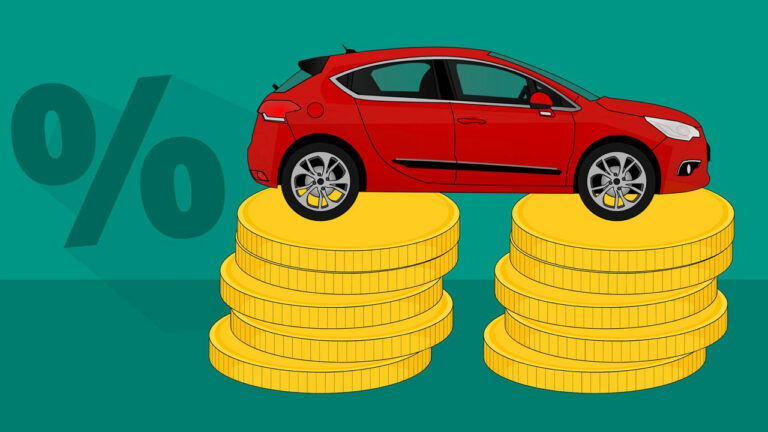“How many cars sold in the US per year?” is a common question among industry analysts, car buyers, sellers, and automotive businesses. If you have been wondering what the sales trend in the US market looks like now, you have come to the right article. Let’s take a look at the current stats and sales figures!

January’s passenger car sales are looking quite promising with a 1.4% increase and SUV and truck sales increased also by 2.4%. According to Cox Automotive, we should be expecting up to 15.7 million sales of new cars in the US in 2024. Let’s keep watching the trend. For now, we will look at the historical trends and growth patterns in the next section.
Motor Vehicle Sales in the US: Historical Trends and Growth Patterns
As you can see from the chart above, auto sales in the US are not always predictable. There are months where we see passenger car sales peak and others where it all just comes down to record lows. This has been the case since 1951.
In the post-World War II era, car ownership became increasingly common, leading to an increase in sales throughout the 1960s. These were good times to be a car manufacturer as up to 9.6 million cars were sold in 1968.
However, sales decreased shortly after. The oil crisis of 1973 led to fuel shortages and skyrocketing prices, causing a sharp decline in car sales from 11.42 million to 8.85 million cars produced within 12 months as consumers sought out more fuel-efficient options in 1974.
Despite this setback, the industry rebounded in the 1980s to 11.41 million new car sales by introducing innovative models and marketing strategies. From here, sadly, there was a steady decrease in the number of monthly sales in the US and it went on year after year.
Things started to look bright in 2014 with up to 7.71 million new vehicle sales in the US but COVID came soon after and this brought sales down to 2.86 million cars in 2022. Note that these numbers do not include light vehicle sales.
Here’s a chart for a more detailed overview of historical trends and automotive sales volume:

Factors Affecting How Many Cars Sold in The US Per Year
Now, you may be wondering why car volume yearly isn’t as stable as it should be. Even if it doesn’t remain constant yearly, it shouldn’t be as low as it was in 2022, right? So what factors affect car sales in the US?
Economic Conditions
The state of the economy plays a crucial role in determining consumer spending habits and the cars sold in US per year. During economic growth and low unemployment rates, consumers are more likely to purchase new vehicles. Conversely, during economic downturns or recessions, consumers may postpone big-ticket purchases like cars, leading to a decline in sales.
Interest Rates
Interest rates directly impact the affordability of car financing. When interest rates are low, financing a car becomes more attractive, and many new cars are sold. Conversely, higher interest rates can deter consumers from taking out loans for new vehicles, resulting in decreased sales.
Fuel Prices
Fluctuations in fuel prices can influence consumer preferences for vehicle types and in turn influence how many cars sold in the US per year. During periods of high fuel prices, there is often greater demand for fuel-efficient vehicles such as hybrids and electric cars. Conversely, lower fuel prices may drive demand for larger, less fuel-efficient vehicles like SUVs and trucks.
Regulatory Environment
Government regulations regarding emissions standards, safety requirements, and fuel efficiency targets can impact the types of vehicles available for sale and their associated costs. Compliance with regulatory mandates may necessitate changes in vehicle design and production, affecting sales volumes and pricing.
Technological Advancements
Advances in automotive technology, such as improvements in fuel efficiency, safety features, and connectivity, can influence consumer purchasing decisions. Vehicles equipped with the latest technology may command higher sales volumes, particularly among tech-savvy consumers.
READ ALSO: Car Data API: What is it and Why is it Important? (Explained)
Current State of the US Automotive Sales Market
Now that we have taken a good look at how many cars sold in US per year, let’s check out some interesting statistics. Do you know which brands and vehicle types hold the highest market share?
2023 USA Car Sales Report (Light-Vehicles Inclusive)
| Automaker | Quarter | Sold Autos | USA Rank |
GM | Q1 | 603,208 | 1 |
| Q2 | 691,978 | 1 | |
| Q3 | 674,336 | 1 | |
| Q4 | 625,176 | 1 | |
| YTD | 2,594,698 | 1 | |
Toyota | Q1 | 469,558 | 2 |
| Q2 | 568,962 | 2 | |
| Q3 | 590,296 | 2 | |
| Q4 | 619,661 | 2 | |
| YTD | 2,248,477 | 2 | |
Ford | Q1 | 465,972 | 3 |
| Q2 | 541,662 | 3 | |
| Q3 | 500,504 | 3 | |
| Q4 | 487,840 | 3 | |
| YTD | 1,995,978 | 3 | |
Hyundai Kia | Q1 | 382,354 | 4 |
| Q2 | 420,361 | 5 | |
| Q3 | 416,327 | 4 | |
| Q4 | 433,779 | 4 | |
| YTD | 1,652,821 | 4 | |
Stellantis | Q1 | 370,347 | 5 |
| Q2 | 434,648 | 4 | |
| Q3 | 380,563 | 5 | |
| Q4 | 343,552 | 5 | |
| YTD | 1,529,110 | 5 | |
Honda | Q1 | 284,507 | 6 |
| Q2 | 347,025 | 6 | |
| Q3 | 339,143 | 6 | |
| Q4 | 337,511 | 6 | |
| YTD | 1,308,186 | 6 | |
Nissan | Q1 | 235,818 | 7 |
| Q2 | 244,353 | 7 | |
| Q3 | 216,878 | 7 | |
| Q4 | 201,747 | 7 | |
| YTD | 898,796 | 7 | |
Tesla | Q1 | 181,000 | 8 |
| Q2 | 173,000 | 8 | |
| Q3 | 157,000 | 10 | |
| Q4 | 144,000 | 10 | |
| YTD | 655,000 | 8 | |
Subaru | Q1 | 143,376 | 9 |
| Q2 | 160,716 | 10 | |
| Q3 | 163,131 | 8 | |
| Q4 | 164,863 | 9 | |
| YTD | 632,086 | 9 | |
VW | Q1 | 138,416 | 10 |
| Q2 | 166,330 | 9 | |
| Q3 | 157,011 | 9 | |
| Q4 | 170,233 | 8 | |
| YTD | 631,990 | 10 | |
BMW | Q1 | 89,795 | 11 |
| Q2 | 87,948 | 13 | |
| Q3 | 91,849 | 11 | |
| Q4 | 126,149 | 11 | |
| YTD | 395,741 | 11 | |
Mazda | Q1 | 88,379 | 12 |
| Q2 | 95,399 | 12 | |
| Q3 | 88,839 | 13 | |
| Q4 | 90,737 | 12 | |
| YTD | 363,354 | 12 | |
Mercedes | Q1 | 80,000 | 13 |
| Q2 | 96,019 | 11 | |
| Q3 | 90,011 | 12 | |
| Q4 | 90,014 | 13 | |
| YTD | 351,745 | 13 | |
Volvo | Q1 | 26,483 | 14 |
| Q2 | 33,267 | 14 | |
| Q3 | 32,375 | 14 | |
| Q4 | 36,576 | 14 | |
| YTD | 128,701 | 14 | |
Mitsubishi | Q1 | 20,938 | 15 |
| Q2 | 24,602 | 15 | |
| Q3 | 22,196 | 15 | |
| Q4 | 19,604 | 16 | |
| YTD | 87,340 | 15 | |
Jaguar Land Rover | Q1 | 20,100 | 16 |
| Q2 | 15,471 | 16 | |
| Q3 | 18,545 | 16 | |
| Q4 | 26,017 | 15 | |
| YTD | 80,133 | 16 | |
Rivian | Q1 | 7,946 | 17 |
| Q2 | 12,640 | 17 | |
| Q3 | 15,564 | 17 | |
| Q4 | 13,972 | 17 | |
| YTD | 50,122 | 17 | |
Total Car Sales in 2023 | Q1 | 3,603,898 | |
| Q2 | 4,114,381 | ||
| Q3 | 3,954,568 | ||
| Q4 | 3,931,431 | ||
| YTD | 15,604,278 |
“Auto Industry Sales Report | USA | Car Sales Data by Quarter.”
Empower Your Automotive Business with Vehicle Databases
Now that you have accurate statistics on new and used car sales in the US, you can understand consumer behavior based on these trends and use this to improve your business services and efficiency. But it doesn’t end there.
We provide a Sales History API that can be used to gain insights into the sales history of any vehicle with images of the vehicle if available. With this API, your business can have full access to the
- Sale price of any vehicle
- Seller type
- Features of vehicles
- Seller description
- High-resolution images.
We closely monitor the sales across all states and cities and can provide you with the market value and sales history of over 31 million vehicles.
Having access to accurate information in the automotive industry gives you and your business a competitive edge over others.
Here are some Application Programming Interfaces you can integrate into your application or website to access vehicle records accurately:
- OCR API Services
- VIN Decoding API
- Classic VIN Decoder API
- Vehicle Specification API
- Vehicle Market value API
- Vehicle Services API
- License Plate API
- Auction History API
- Sales History API
- VIN Title Check API
- Vehicle Media API
- Window Sticker API
- Electric Vehicle Specifications API
Sign up now with Vehicle Databases and have all the power you need to take your business to the next level.



